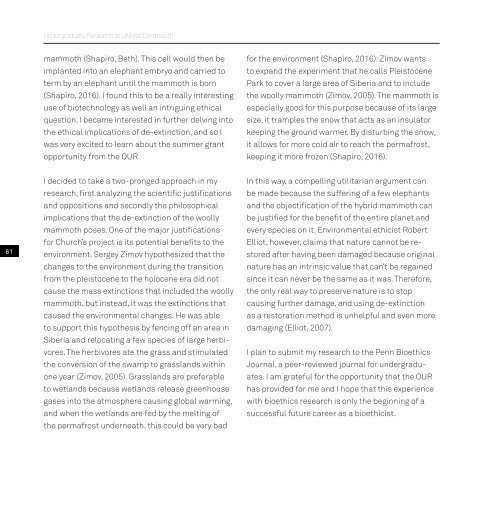Undergrad_Book_16-18_Pge_View_Print_no print marks_compressed
You also want an ePaper? Increase the reach of your titles
YUMPU automatically turns print PDFs into web optimized ePapers that Google loves.
<strong>Undergrad</strong>uate Research at UMass Dartmouth<br />
mammoth (Shapiro, Beth). This cell would then be<br />
implanted into an elephant embryo and carried to<br />
term by an elephant until the mammoth is born<br />
(Shapiro, 20<strong>16</strong>). I found this to be a really interesting<br />
use of biotech<strong>no</strong>logy as well an intriguing ethical<br />
question. I became interested in further delving into<br />
the ethical implications of de-extinction, and so I<br />
was very excited to learn about the summer grant<br />
opportunity from the OUR.<br />
for the environment (Shapiro, 20<strong>16</strong>). Zimov wants<br />
to expand the experiment that he calls Pleistocene<br />
Park to cover a large area of Siberia and to include<br />
the woolly mammoth (Zimov, 2005). The mammoth is<br />
especially good for this purpose because of its large<br />
size, it tramples the s<strong>no</strong>w that acts as an insulator<br />
keeping the ground warmer. By disturbing the s<strong>no</strong>w,<br />
it allows for more cold air to reach the permafrost,<br />
keeping it more frozen (Shapiro, 20<strong>16</strong>).<br />
61<br />
I decided to take a two-pronged approach in my<br />
research, first analyzing the scientific justifications<br />
and oppositions and secondly the philosophical<br />
implications that the de-extinction of the woolly<br />
mammoth poses. One of the major justifications<br />
for Church’s project is its potential benefits to the<br />
environment. Sergey Zimov hypothesized that the<br />
changes to the environment during the transition<br />
from the pleistocene to the holocene era did <strong>no</strong>t<br />
cause the mass extinctions that included the woolly<br />
mammoth, but instead, it was the extinctions that<br />
caused the environmental changes. He was able<br />
to support this hypothesis by fencing off an area in<br />
Siberia and relocating a few species of large herbivores.<br />
The herbivores ate the grass and stimulated<br />
the conversion of the swamp to grasslands within<br />
one year (Zimov, 2005). Grasslands are preferable<br />
to wetlands because wetlands release greenhouse<br />
gases into the atmosphere causing global warming,<br />
and when the wetlands are fed by the melting of<br />
the permafrost underneath, this could be very bad<br />
In this way, a compelling utilitarian argument can<br />
be made because the suffering of a few elephants<br />
and the objectification of the hybrid mammoth can<br />
be justified for the benefit of the entire planet and<br />
every species on it. Environmental ethicist Robert<br />
Elliot, however, claims that nature can<strong>no</strong>t be restored<br />
after having been damaged because original<br />
nature has an intrinsic value that can’t be regained<br />
since it can never be the same as it was. Therefore,<br />
the only real way to preserve nature is to stop<br />
causing further damage, and using de-extinction<br />
as a restoration method is unhelpful and even more<br />
damaging (Elliot, 2007).<br />
I plan to submit my research to the Penn Bioethics<br />
Journal, a peer-reviewed journal for undergraduates.<br />
I am grateful for the opportunity that the OUR<br />
has provided for me and I hope that this experience<br />
with bioethics research is only the beginning of a<br />
successful future career as a bioethicist.



